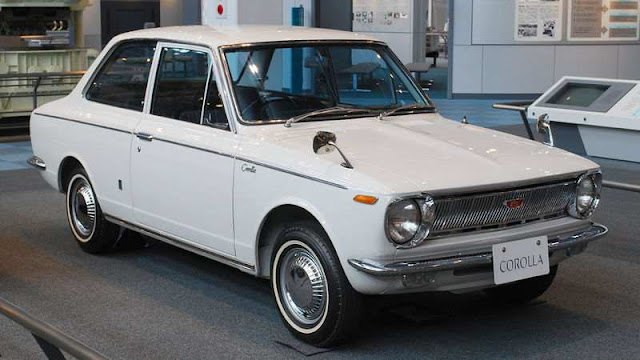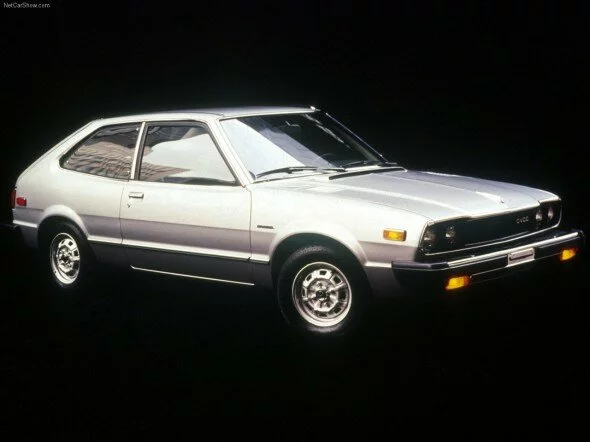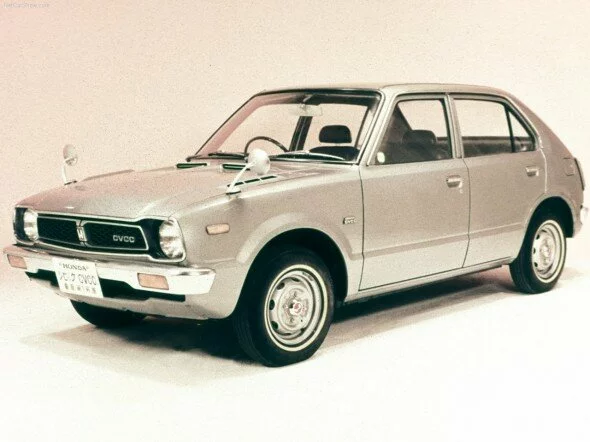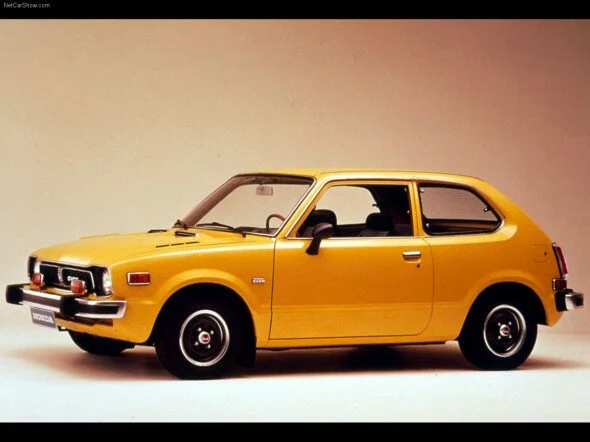September 28, 2010 – 4:10 pm
+-+1966+1.jpg)
|
| Toyota Corolla First Generation (E10) – 1966 |
Toyota Corolla First Generation (E10) Specifications :
Manufacturer : Toyota
Productions : 1966
Engine : 1100 cc
+-+1966+2.jpg)
|
| Toyota Corolla First Generation (E10) – 1966 |
+-+1966.jpg)
|
| Toyota Corolla First Generation (E10) – 1966 |
Photo Credit : japanclassiccargallery.blogspot.com and extremecorolla.wordpress.com
October 29, 2010 – 1:19 am
Toyota Corolla E30 Specifications :
Manufacturer : Toyota
Productions : 1974–1981
Body style : 2-door, 2-door sedan, 4-door sedan, 2-door hardtop coupé, 3-door liftback, 3-door station wagon, 5-door station wagon, 3-door van
Layout : FR layout
Engine(s) : 1.2 L I4 3K, 1.3 L I4 4K, 1.4 L I4 T, 1.6 L I4 2T, 1.6 L I4 12T
Transmission : 2-speed automatic, 3-speed automatic, 4-speed manual
5-speed manual.
Photo Credit : Bidgee

 Manufacturer : Honda
Manufacturer : Honda
 Productions : 1976
Productions : 1976
 Engine : 75hp, 1751cc EK1 CVCC
Engine : 75hp, 1751cc EK1 CVCC
 Source : netcarshow.com
Source : netcarshow.com
The Honda Accord is an automobile manufactured by Honda. The Accord was introduced in 1976 as a compact hatchback, with styling similar to an upsized contemporary Honda Civic. A four-door sedan was debuted in 1977.
read more »
January 24, 2011 – 3:16 pm
 Manufacturer : Volkswagen
Manufacturer : Volkswagen
 Productions : 1977-1979
Productions : 1977-1979
 Engine : 50 PS (37 kW) 1043 cc
Engine : 50 PS (37 kW) 1043 cc
 Source : netcarshow.com
Source : netcarshow.com
The Mk I Polo, a rebadged version of the Audi 50, was introduced in 1975. The differences between the Audi and VW models were minor, with the Polo being cheaper and much more basic. The two cars were initially sold along side each other, but the Audi 50 never sold as well, and was withdrawn in 1978. The Polo was manufactured at the Volkswagen plant in Wolfsburg. In 1977, the Derby sedan was released, which was simply a Polo, identical to the hatchback from the C-pillar forward, with a large boot attached (an old Audi proposal, but never sold by this brand).
When first on sale the range topping car, the LS model, featured the 50 PS (37 kW) 1043 cc engine found in the Audi 50. Other specifications included parking lights, rear wash wipe, sun visors, chromed bumpers and 4.5J X 13″ wheels. The N model was the basic starting spec lacking many of the features of the LS. In 1979 the GLS was introduced, replacing the LS as the range-topping car; specification upgrades included chrome headlight and grill surrounds, sunroof, a cigarette lighter and chrome wheel trims.
895 cc, 1093 cc and 1272 cc engines were used, with the smaller one used only in the Polo hatchback, and the 1272 cc only in the Derby, Audi 50, and the rare Polo GT. Different levels of compression were used on each size to achieve different power outputs, and the variations are numerous, often differing depending on the country of sale, ranging from 35 to 60 PS (26 to 44 kW).
 Manufacturer : Subaru
Manufacturer : Subaru
 Productions : 1971-1989
Productions : 1971-1989
 Engine : GLF. Turbocharged engine
Engine : GLF. Turbocharged engine
 Transmission : 5-speed or automatic transmission
Transmission : 5-speed or automatic transmission
 Source : netcarshow.com
Source : netcarshow.com
The Subaru Leone is a compact automobile produced by Subaru from June 1971 to February 1989 when it was replaced by the Subaru Loyale, which was essentially the same car, only with a different name. The Leone was known as the “GL/DL” in North America. The Leone was offered in sedan and hardtop coupe format from launch and station wagon format starting in September 1972.
This nameplate covered three generations of compact Subaru; the dates given below are for North American-market vehicles.
- 1972 model year – GF hardtop coupe offered alongside existing G-series sedans and wagon.
- 1973 model year; G series replaced by new (Loyale) two- and four door sedans and 5-door wagon.
- 1975 model year – All-wheel drive wagon offered.
- 1978 – AWD-only pickup added, marketed as Subaru Brat in North America and Subaru Brumby in Australia. Sedans and wagons offered in plainer DL and fancier GL trim.
- 1980 – SECOND GENERATION – restyled body for passenger cars. Two-door sedan dropped, replaced by 3-door hatchback on a shorter wheelbase than the others, available with AWD. Pickup continues on old body. 5-speed manual transmission supplied with 2WD GL sedans and wagon and GLF hardtop.
- 1982 – Pickup now restyled, catches up with passenger cars.
- 1983 – GL now midlevel trim, fancier GL-10 trim for all bodystyles replaces hardtop-only GLF. Turbocharged engine (“Turbo-Traction”) available on AWD GL-10s. AWD now available on sedans and hardtops, and with 5-speed or automatic transmission for the first time. Minor trim changes for all models include “honeycomb” grille texture, Mercedes-style ribbed taillight lenses, and plastic-covered bumpers (except North American 2wd models). GL and GL-10 now have quad headlights.
- 1985 – THIRD GENERATION sedan and wagon with larger, angular body. Quad headlights now on base DL, composite headlights on GL and GL-10. Hardtop discontinued, second gen. hatchback and pickup continue without change.
read more »
January 18, 2011 – 9:07 am
 Manufacturer : Toyota
Manufacturer : Toyota
 Productions : 1978-1984
Productions : 1978-1984
 Engine : 993 cc 2K I4, 1166 cc 3K I4, 1290 cc 4K I4
Engine : 993 cc 2K I4, 1166 cc 3K I4, 1290 cc 4K I4
 Transmission : K40 (4-speed manual), K50 (5-speed manual)
Transmission : K40 (4-speed manual), K50 (5-speed manual)
 Source : wikipedia.org
Source : wikipedia.org
Description : The 60 series, introduced in 1978 was better known, being the first to be extensively sold outside Japan. It was offered with 993 (KP60 2K), 1,166 (KP62 3K) and 1,290 cc (KP61 4K) engines. Three- and five-door hatchbacks were offered in export markets, although a distinctive 5-door wagon variant was sold in Japan, Hong Kong and Germany. Trim levels were Standard, De Luxe (also known as DX in some markets), GL, XL, S, and SE.
In 1980 the Starlet was facelifted to include square headlights and a second facelift followed in 1983 to incorporate a slant nose front end, and lower hatch opening.
The KP61 was the only Starlet ever sold in the USA from 1981 to 1984, and the Toyota Corolla FX replaced it in 1985. The 1981–1982 models came with standard 5-speed manual transmission and tachometer. It is an equivalent to other markets’ S model. The 1983–1984 models were additionally offered with Electronic Fuel Injection (EFI) with the 4K engine, but with 4-speed manual transmission, and similar to other markets’ XLi model.

 Manufacturer : Honda
Manufacturer : Honda
 Productions : 1972-1973
Productions : 1972-1973
 Engine : 1170 cc engine
Engine : 1170 cc engine
 Transmission : four-speed automatic transmission
Transmission : four-speed automatic transmission
 Source : netcarshow.com
Source : netcarshow.com
The Honda Civic is an automobile manufactured by Honda. It was introduced in July 1972 as a two-door coupe, followed by a 3-door hatchback version that September. With the transverse engine placement of its 1169 cc engine and front wheel drive, like the British Mini, the car provided good interior space despite overall small dimensions.
Early models of the Civic were typically outfitted with a basic AM radio, rudimentary heater, foam cushioned plastic trim, two-speed wipers, and painted steel rims with a chromed wheel nut cap. The current Civic has become much more luxurious with satellite-linked navigation, a six-speed manual, power locks and power windows available. Still, many regard the Civic as representing a good value for the money, combining good performance, reliability and economy, as well as a very low rate of depreciation.
The Civic evolved from having a 1170 cc engine (1973) to having engines with larger capacities and more creature comforts (air conditioning, power windows, etc.) through the 1980s, 1990s and into the 2000s.
read more »
 Manufacturer : Lotus
Manufacturer : Lotus
 Productions : 1973
Productions : 1973
 Engine : aluminium-block 4-valve, DOHC, four cylinder, 2.0 L engine
Engine : aluminium-block 4-valve, DOHC, four cylinder, 2.0 L engine
 Transmission : 5-speed gearbox standard; from January 1976 an automatic transmission
Transmission : 5-speed gearbox standard; from January 1976 an automatic transmission
 Source : netcarshow.com
Source : netcarshow.com
Lotus’ first saloon car was front engined with rear wheel drive. Like all production Lotuses since the Elan, the Elite II used fiberglass for the hatchback bodyshell, mounted on a steel backbone chassis evolved from the Elan and Europa. It had 4-wheel independent suspension using coil springs. Power steering and air conditioning were optional from 1974. The Elite II was the basis for the Eclat, and the later Excel four-seaters.
The Elite II was Lotus’ first car to use the “907″ aluminium-block 4-valve, DOHC, four cylinder, 2.0 L engine. (The 907 engine had previously been used in Jensen-Healeys.) The 907 engine ultimately became the foundation for the Lotus Esprit powerplants, both naturally-aspirated and turbocharged. Elite IIs were available with a 5-speed gearbox standard; from January 1976 an automatic transmission was optional.
Regarding performance, the Elite and Elite II (and the related Eclat) are notable in that the stock curb weight is not much over 2000 lb (907 kg). Once the motors reach their power band, both acceleration and handling are impressive.

 Manufacturer : Honda
Manufacturer : Honda
 Productions : 1972-1975
Productions : 1972-1975
 Engine : 1170 cc
Engine : 1170 cc
 Transmission : 1335 cc giving 55 hp to 1488 cc giving 67 hp
Transmission : 1335 cc giving 55 hp to 1488 cc giving 67 hp
 Source : netcarshow.com
Source : netcarshow.com
The Honda Civic is an automobile manufactured by Honda. It was introduced in July 1972 as a two-door coupe, followed by a 3-door hatchback version that September. With the transverse engine placement of its 1169 cc engine and front wheel drive, like the British Mini, the car provided good interior space despite overall small dimensions.
Early models of the Civic were typically outfitted with a basic AM radio, rudimentary heater, foam cushioned plastic trim, two-speed wipers, and painted steel rims with a chromed wheel nut cap. The current Civic has become much more luxurious with satellite-linked navigation, a six-speed manual, power locks and power windows available. Still, many regard the Civic as representing a good value for the money, combining good performance, reliability and economy, as well as a very low rate of depreciation.
read more »
+-+1966+1.jpg)
+-+1966+2.jpg)
+-+1966.jpg)














